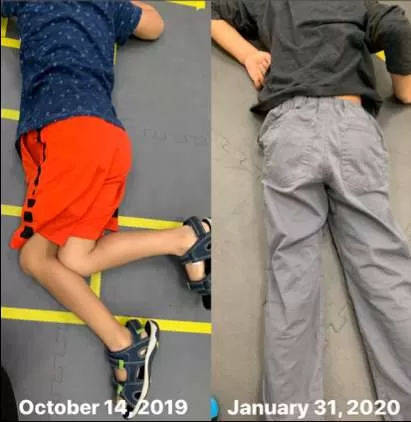Scoliosis
Can Rhythmic Movements & Reflex Integration Help Scoliosis?
 Photos courtesy of Tiffany Mabin, MS, OTR/Lby Sonia Story, M.S.
Photos courtesy of Tiffany Mabin, MS, OTR/Lby Sonia Story, M.S.
While there are many possible contributing factors in scoliosis, when the Spinal Galant reflex is unintegrated on one side, it is associated with scoliosis (Sharma & Saxena, 2024; Gieysztor et al., 2018; Ferrari et al., 2010) and with issues involving posture and gait (Goddard, 2023).
The photos here show a child with scoliosis who could not comfortably be flat on the floor in prone. His occupational therapist used the innate rhythmic movements and Spinal Galant reflex integration from the Brain and Sensory Foundations, First Level (Part 1) course to help him. In 3.5 months he showed major improvements. His OT reported:
"…curvature of his spine was no longer visible, he was able to maintain prone position comfortably."
Tiffany Mabin, MS, OTR/L
This OTs experience with this boy is supported by researchers who concluded that integration of primitive reflexes in children ages 5 to 9 may be helpful in the treatment of scoliosis and posture defects (Gieysztor et al., 2018).
In addition to using integrative and neurodevelopmental movements to help with scoliosis, it is also important to get advice and treatment from a health practitioner.
References
Ferrari, A., Ferrara, C., Balugani, M., & Sassi, S. (2010). Severe scoliosis in neurodevelopmental disabilities: clinical signs and therapeutic proposals. European Journal of Physical and Rehabilitation Medicine, 46(4), 563-580.
Gieysztor, E. Z., Sadowska, L., Choińska, A. M., & Paprocka-Borowicz, M. (2018). Trunk rotation due to persistence of primitive reflexes in early school-age children. Advances in Clinical and Experimental Medicine, 27(3), 363-366.
Goddard Blythe, S. (2023). Reflexes, movement, learning & behavior. Analysing and unblocking neuro-motor immaturity. Hawthorn Press.
Sharma, Y., & Saxena, A. (2024). Problems Associated with Persisting Primitive Reflex in Healthy School-going Children. Journal of Clinical & Diagnostic Research, 18, 60-61.
Sonia Story, M.S. has been teaching neurodevelopmental movements since 2006.
Sonia developed the Brain and Sensory Foundations program to provide comprehensive training in neurodevelopmental movements—combining innate rhythmic movements, play, primitive reflexes, and postural reflexes.
She earned a Bachelor's degree in biology/psychology and a Master’s degree in Movement Sciences. She is the author of The Importance of Reflex Integration and the Evidence eBook, giving the rationale and evidence basis for using neurodevelopmental movements for helping with challenges such as ADHD, Sensory Processing Disorders, anxiety, emotional dysregulation, visual skill deficits, poor social skills, gross and fine motor delays and other neurodevelopmental and behavioral disorders.
Her work is featured in numerous podcasts, summits, and conferences, and in the books Almost Autism: Recovering Children from Sensory Processing Disorder; Special Ed Mom Survival Guide; Family Health Revolution; and Same Journey, Different Paths—Stories of Auditory Processing Disorder.
Sonia’s mission is to help children and families experience the profound benefits of neurodevelopmental and integrative movements for more functional and fulfilling lives.


